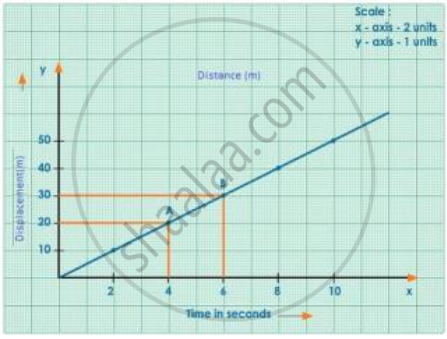Advertisements
Advertisements
Question
The following table gives the displacement of a car at different instants of time.
| Time (s) | 0 | 1 | 2 | 3 | 4 |
| Displacement (m) | 0 | 5 | 10 | 15 | 20 |
- Draw the displacement-time sketch and find the average velocity of the car.
- What will be the displacement of the car at (i) 2.5 s and (ii) 4.5 s?
Solution
a.
Displacement-time graph
From the part AB of the graph,
Average velocity = `("Displacement at B - Displacement at A")/"Time taken"`
= `((30 - 20) m)/((6 - 4) s)`
= `(10/2)` m/s
= 5 m/s
(b)
- From the graph, the displacement of car at 2.5 s is 12.5 m.
- From the graph, the displacement of car at 4.5 s is 22.5 m.
APPEARS IN
RELATED QUESTIONS
If on a round trip you travel 6 km and then arrive back home :
What distance have you travelled ?
If on a round trip you travel 6 km and then arrive back home :
What is your final displacement ?
Differentiate between distance and displacement.
Draw a velocity-time graph for a body moving with an initial velocity u and uniform acceleration a. Use this graph to find the distance travelled by the body in time t.
How is the distance related with time for motion under uniform acceleration such as the motion of a freely falling body?
Write an expression for the distance S covered in time t by a body which is initially at rest and starts moving with a constant acceleration a.
A body starts with an initial velocity of 10m s-1 and acceleration 5 m s-2. Find the distance covered by it in 5 s.
Define Displacement.
A body moves along a circular path of radius r. When it completes three complete rounds, what is the ratio of distance covered to its displacement?
Which of the following figures represent uniform motion of a moving object correctly?
